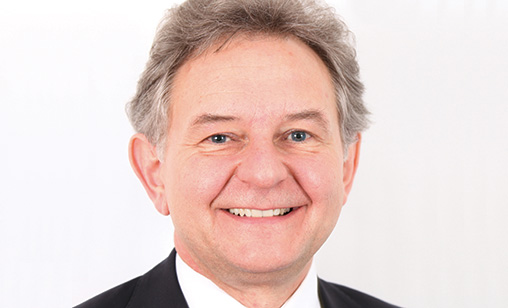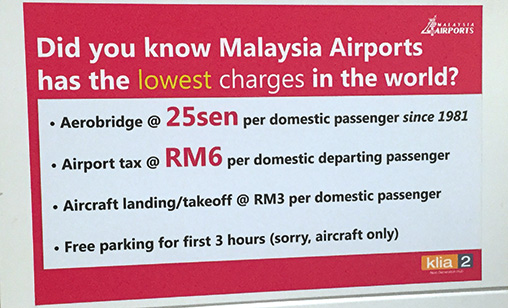News Backgrounder
Malaysia forced to backtrack on pre-emptive fee strike
Malaysia’s decision to increase airport fees ten fold from last month was postponed after airlines and their associations protested vehemently. The government backed down and only doubled fees, but warned more incremental fee increases were inevitable.
May 1st 2016
When Malaysia’s Department of Civil Aviation (DCA) told airlines early last month they would have to pay up to ten times more in fees for aviation services from April 15, it was an unwelcome shock. Read More »
Carriers using the country’s airports and airways knew increases were on the way because they had been briefed about them. But they understood there would be industry consultations before fees were struck.
 |
| IATA Asia Pacific regional director Conrad Clifford: discussions between stakeholders essential before additional fee increases are decided for airlines servicing Malaysia |
The airlines came out fighting. After their strong rearguard reaction and an urgent day of discussions between the airlines’ representatives and the DCA, it was decided to only double fees – for everything from airspace use to air traffic facilities, air operator’s certificates (AOC) and pilot licences.
“We welcome the Malaysian government’s announcement to temporarily defer the steep increases to the air navigation charges following urgent engagement with the industry over the last few days,” said the International Air Transport Association’s (IATA) regional vice president for the Asia-Pacific, Conrad Clifford.
“Nonetheless, we remain concerned that charges still doubled, effective from 15 April. Moving forward, robust consultations with industry will be critical before any more increases are introduced.”
The Association of Asia Pacific Airlines (AAPA) director general, Andrew Herdman, said: “The proposed changes were announced without prior consultation with the airline industry as the main users of such services.
“As a general principle, ICAO’s (International Civil Aviation Organization) Policies on Charges for Airports and Air Navigation Services prescribes that user charges should be non-discriminatory, transparent and determined in close consultation with industry stakeholders.”
The increased fees in Malaysia were not the only new costs airlines in the region will need to build into their ticket prices. At Dubai and Sharjah in the Middle East, a new “airport facilities fee” of $9.53 per departing passenger will apply from June 30.
The fee will go towards the expansion of the airports and is in addition to a $20.42 service fee and a $1.36 security fee already imposed on travelers at Sharjah International and Dubai International airports.
For now, a truce prevails in Malaysia. Transport Minister, Liow Tiong Lai, speaking after negotiations ended, said the Air Navigation Facilities Charge (ANFC) to airline operators would be implemented in stages with a maximum one-fold increase. They will not be more than doubled at any one time.
“I have instructed the DCA to prepare a comprehensive plan for future fees and charges, that will be implemented in stages, in our effort to remain competitive with neighbouring countries,” the transport minister said. At press time, no timetable had been announced for future fee increases although there are suggestions they may rise on an annual basis.
There is justification for fee increases for Malaysia’s airport and aviation services. The charges are among the lowest in the region, Liow said, and added the industry had been heavily subsidized by the government since the 1970s.
“A point to note is that the Air Navigation Facilities Charge (AFC) has not been changed for well over 40 years. Other charges such as the issuance of an AOC or a Certificate of Airworthiness have not been revised since 1996. These costs and much more have continued to be subsidized by the government. This cannot continue. As such, the necessity for the revision in fees,” he said.
 |
| Before April 15, 2016 |
It is hardly surprising the original plan for the fee increases stunned both domestic and international airlines. If they had gone ahead an airline that pays ANFC fees of US$30,000 a month would face new charges of $308,000 for the same period.
The new fee structure would have forced airlines to increase their ticket prices. Hardest hit would have been AirAsia, Malaysia Airlines and Malindo Air, who operate several hundred domestic flights every week.
The threat prompted local airlines to immediately set up the Association of Malaysian Air Carriers (AMAC) to provide a common platform to discuss such issues. A press release from AirAsia’s communication department said subject to approval from the respective boards and the Registrar of Society, the founding airlines of the association would be Malaysia Airlines, MASwings, Firefly, AirAsia, AirAsia X, Malindo Air and Berjaya Air.
With all the main operators represented, the association would ensure it had one voice for the airline industry while also representing common industry interests among institutions such as the Transport Ministry, the DCA and the Malaysian Aviation Commission.
“The AMAC will engage in enhanced air traffic control services, aero-political concerns, safety and security standards in airports, charging regimes and other related issues. By joining forces, the association will promote healthier growth for the industry and create highly qualified jobs, both directly and indirectly, for the sector and the broader aviation eco-system,” the announcement said.
IATA’s Clifford said making air travel more expensive would dampen air travel demand and put at risk the substantial potential benefits of aviation to the Malaysian economy. “An IATA commissioned study found that aviation is expected to support one million Malaysian jobs and $26 billion in economic activity in 2035, double that of today,” he said.
“But these jobs and GDP expansion are by no means guaranteed if the necessary infrastructure is not available and if policies, including fees and charges, do not facilitate the growth of the industry.
“The proposed new charge for the Advanced Passenger Screening System (APSS) is one such example. Security is a state function and should be funded from the national budget. There is no justification for airlines or their passengers to pay for it.
“The Malaysian government is a respected member of the ICAO Council and we trust that any further charges will be determined through consultation based on ICAO principles of cost-relatedness and transparency.”
DCA director general, Azharuddin Abdul Rahman, said the DCA has spent US$361.5 million on new ATM infrastructure. The new Kuala Lumpur air traffic control centre, expected to be operational by 2018-2019, will cost the DCA $166.7 million. The department needed about $140 million for the new Kota Kinabalu air traffic control centre and for other system upgrades in Malaysia.
“We are spending about $32 million every year on maintenance. That is why we need to raise our rates. We are essentially building a new air traffic control centre for the benefit of the airlines,” he said.
| Putting customers first brings best returns for airports Customer service is the biggest driver of non-aeronautical revenue at airports and can produce a greater return on investment than traffic growth or additional commercial space, an Airports Council International (ACI) White Paper reported last month. The White Paper is based on an ACI Airport Quality Services (AQS) annual survey of 300 airports worldwide and the views of 550,000 passengers gathered over a year. Its conclusions were supported by ACI’s annual Airport Economics Survey. The annual survey covers 34 areas and includes the key touch points of access, check-in, security, airport facilities and food and beverages. All airports in an AQS survey use the same set of questions with the aim of setting an industry standard of responses to passengers’ perceptions of ACI World member airports. Key findings were: * 1% increase in passenger satisfaction levels delivers a 1.5% increase in non-aeronautical revenue. * 1% increase in passenger traffic drives a non-aeronautical revenue rise from 0.7% to 1%. * 1% increase in commercial space produces an additional 0.2% in non-aeronautical revenue. ACI World director general, Angela Gittens, said: “each airport faces unique issues when determining its investment program, but many airports seize upon traffic and retail space as the key engines of revenue growth when customer service may be the optimal route.” Asia-Pacific best airports for service quality: * Seoul Incheon and Singapore Changi * Beijing, Mumbai, New Delhi, Sanya Phoenix, Shanghai Pudong * Guangzhou Baiyun, Taiwan Taoyuan, Tianjin Binhai Middle East best airports for service quality : * Amman * Abu Dhabi, Doha * Dammam, Dubai, Tel Aviv |